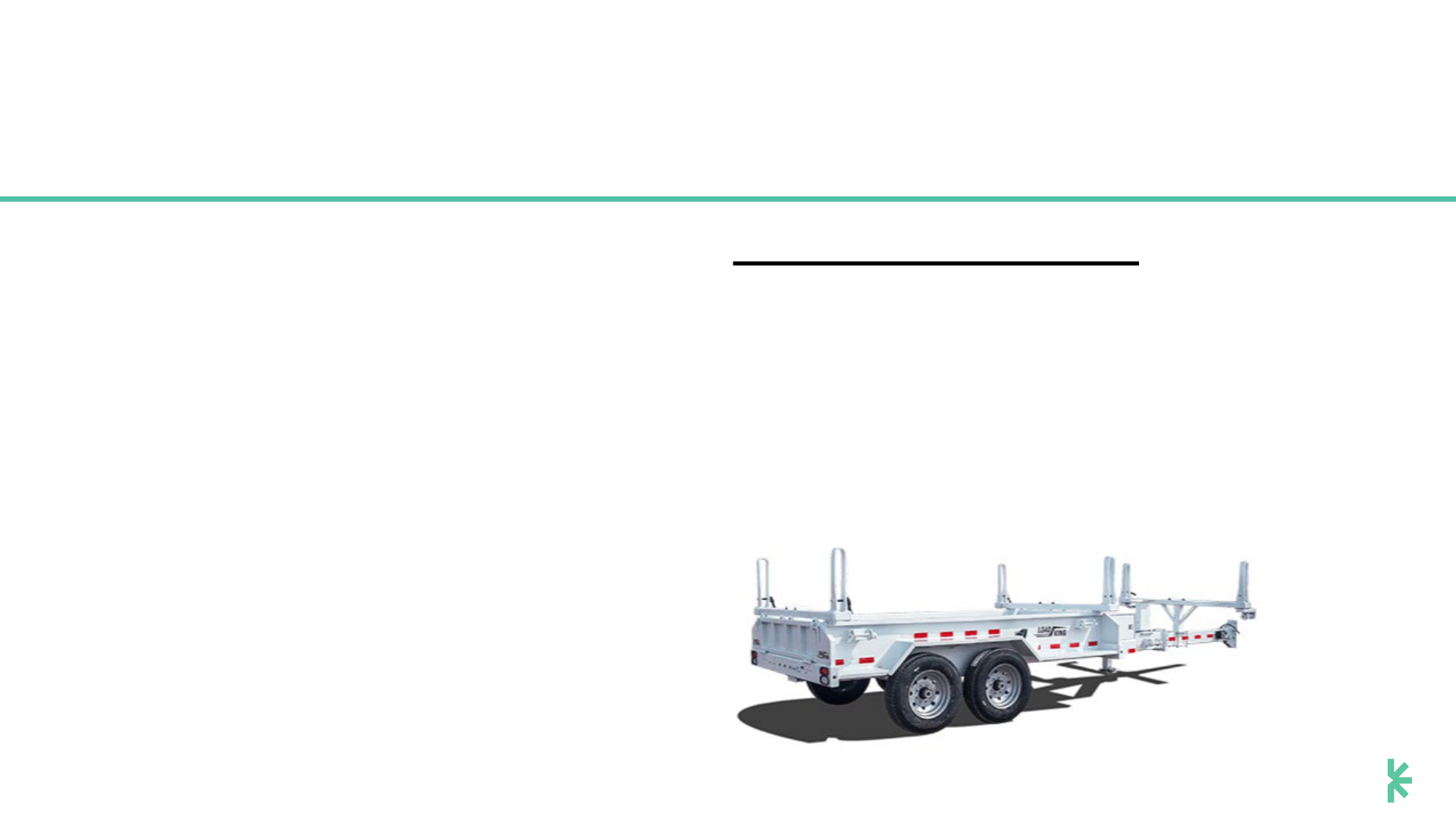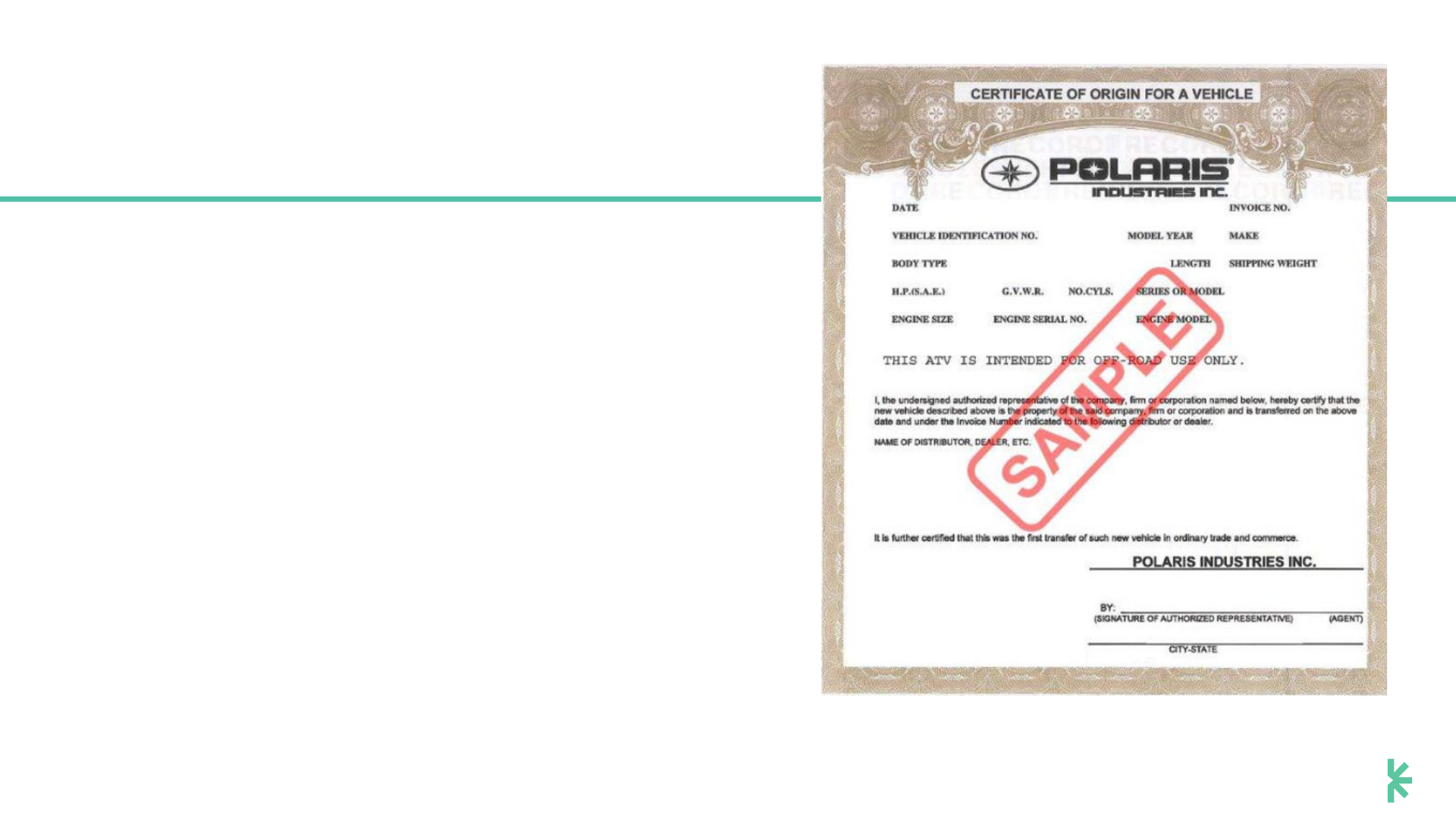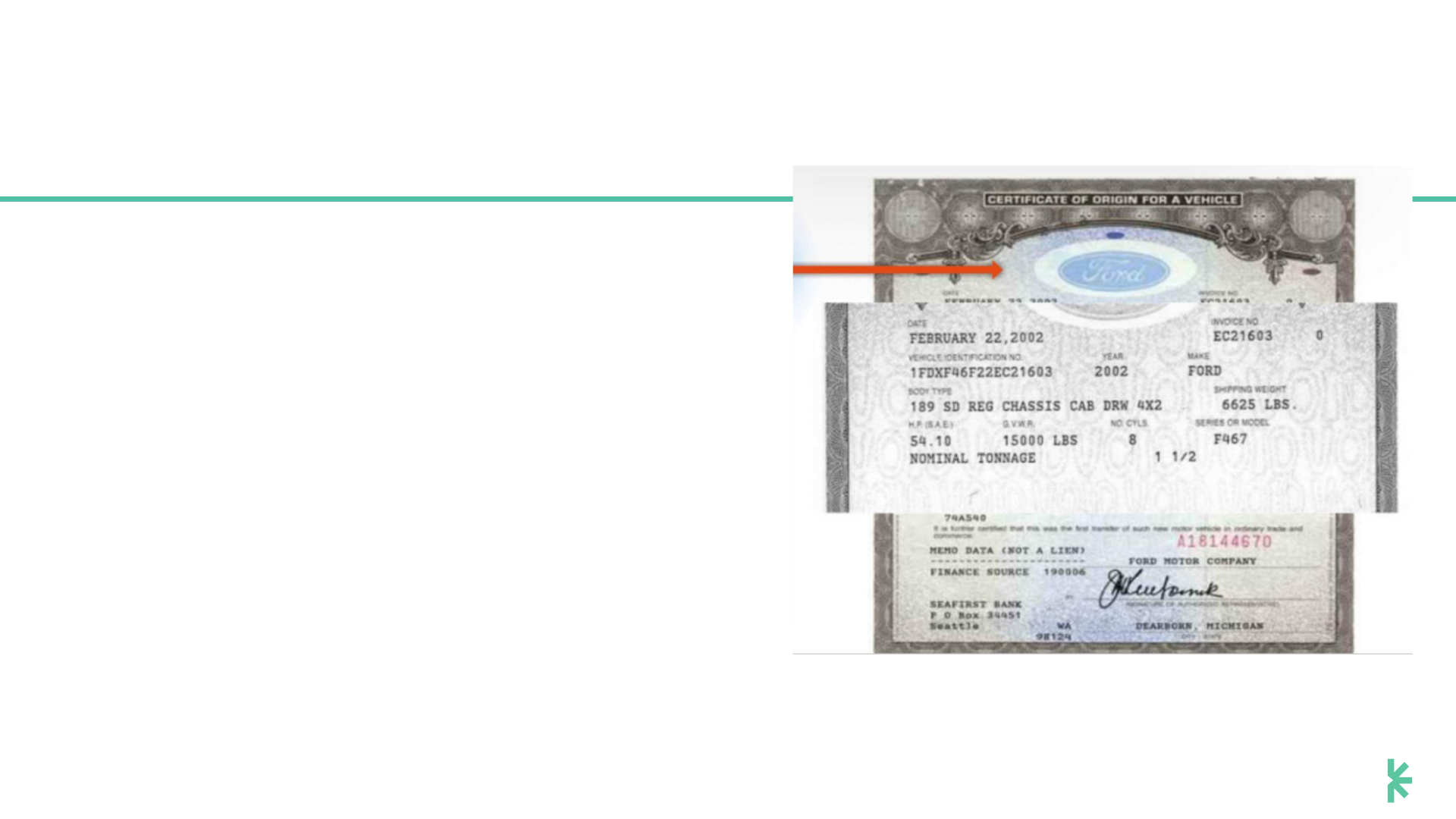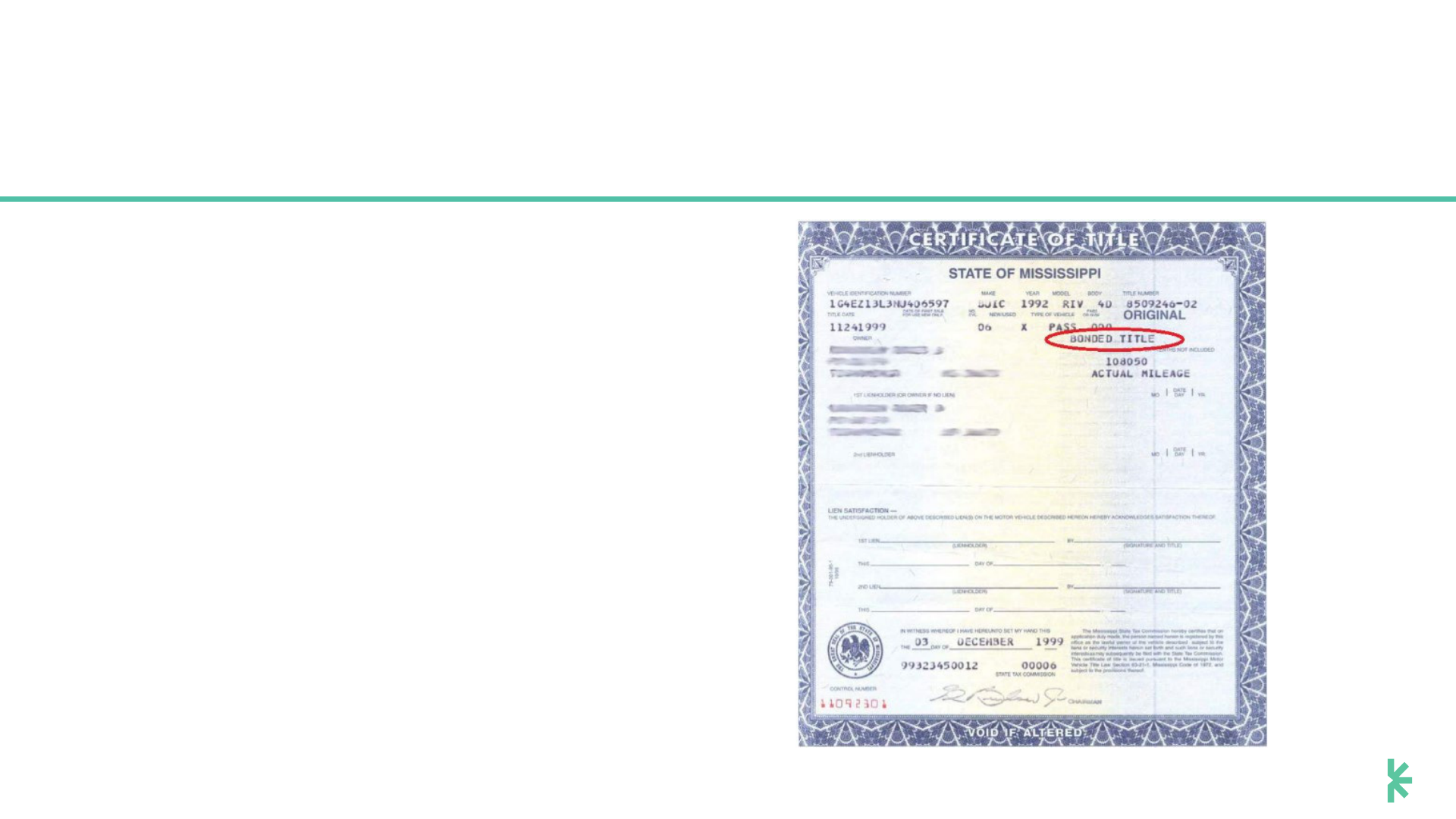
Alabama Department
of Revenue
Motor Vehicle Division
Designated Agent Training Manual

About the Alabama Designated Agent Training
• The designated agent training course is a self-paced, training
tool for designated agents who will use the MyDMV system to
process Alabama title applications.
• The training program is presented in 8 self-paced quizzes.
• If you have any questions, please contact the Motor Vehicle
Division.

The following Topics are Covered in this Course:
• Module 1:Designated Agent Basics
• Alabama title law exemptions, designated agent responsibilities, the title application process, and the Driver Protection Privacy Act (DPPA)
• Module 2: Titles, Fraud Detection, and Remediation
• Security features
• Module 3:Title Application Basics
• Federal Truth in Mileage Act; odometer certification; completing a title assignment; Forms: Reassignment Form MVT 8-3, Correction Affidavit Form MVT 5-7,
and Affidavit for Assignment of Title from a Deceased Owner Form MVT5-6.
• Module 4: Title Assignments
• Primary supporting documents for title applications, sample title documents, title brands that may be found on an Alabama Certificate of Title, other primary
supporting documents, such as: tag receipts, military registrations, title bonds, and court orders
• Module 5: Power of Attorneys and Liens
• Power of Attorneys, Motor Vehicle Division Power of Attorney, Form MVT5-13, Secure Power of Attorney, Form MVT 8-4; How to perfect a lien; How to release
a lien.
• Module 6: Repossessions, Salvage, and Rebuilt Vehicles
• Repossessions, and salvage vehicles
• Module 7:Dealer Tags, Temporary Tags, & Sales Tax
• Dealer Plates, Sales Tax FAQ’s, & Dealer Temporary tags
• Module 8: Managing Title Work
• Logging in and completing Title applications

Designated Agent
Basics
Module 1

Alabama Title Law Exemptions
• The Alabama Uniform Certificate of Title and Anti-Theft Act
exempts certain vehicles
from titling requirements.
• The vehicles described in the following lessons are exempt
from titling
in the State of Alabama.
If a vehicle is not required to be titled, the Department of Revenue does
not maintain records for the vehicle.

If a vehicle is owned by one of the entities or groups below, it is exempt from
titling in the State of Alabama:
• A vehicle owned by the United States government or any agency thereof
• A vehicle owned by a manufacturer or dealer and held for sale, or a vehicle used by a
manufacturer solely for testing.
• A vehicle owned by a non-resident of this state and not required by law to be registered in this
state.
• A vehicle moved solely by animal power
• Vehicles that are low-speed, including neighborhood electric vehicles, defined as four-wheeled
motor vehicles with a top speed of not greater than 25 miles per hour, a gross vehicle weight
rating of fewer than 3,000 pounds, and complying with the safety standards provided in
49
C.F.R. Section 571.500
• Vehicles that are a motor-driven cycle as defined in Code of Alabama, 1975 §32-1-1.1
• Mini-trucks as defined in Code of Alabama, 1975 Section §40-12-240
• An implement of husbandry (equipment that is used exclusively for agriculture).
• Utility trailers (other than moving

General Exemptions
If a vehicle is owned by one of the entities or groups below, it is exempt from titling in the
State of Alabama:
• A vehicle owned by the United States government or any agency thereof
• A vehicle owned by a manufacturer or dealer and held for sale, or a vehicle used by a manufacturer solely for testing.
• A vehicle owned by a non-resident of this state and not required by law to be registered in this state.
• A vehicle does not require titling if an Alabama license plate issuing official has verified that both the current owner
& operator are recorded as the owner and operator on a currently effective certificate of title issued by another state
and the certificate of title is being held by a recorded lienholder.
• A vehicle moved solely by animal power
• Vehicles that are low-speed, including neighborhood electric vehicles, defined as four-wheeled motor vehicles with a
top speed of not greater than 25 miles per hour, a gross vehicle weight rating of fewer than 3,000 pounds, and
complying with the safety standards provided in 49 C.F.R. Section 571.500
• Vehicles that are a motor-driven cycle as defined in Code of Alabama, 1975 §32-1-1.1
• Mini-trucks as defined in Code of Alabama, 1975 Section §40-12-240
• Gooseneck Utility Trailers (20 or less model years) are NOT exempt and DO require titling in Alabama.

Special Mobile Equipment Vehicles &
Other Exemptions
• Every vehicle not designed or used primarily for the transportation of persons or property
and only incidentally operated or moved over the highway is exempt, including but not
limited to:
• Ditch-digging apparatus, road construction & maintenance machinery, bumper-pulled car
hauler trailers, bumper enclosed trailer, utility trailers, boat trailers.
• The term “Special Mobile Equipment Vehicles” does not include:
• Equipment used exclusively for agriculture (an implement of husbandry)
• Vehicles designed for the transportation of persons or property to which machinery has been
attached.
• Utility trailers defined as a vehicle without motive power designed to be drawn by a passenger
car or pickup truck (bumper-pulled), including folding or collapsible camping trailers.
• Bumper pull (enclosed or not)
• Bumper- pulled car hauler trailers
• Modular Home (manufactured homes model year 2000 and newer are subject to titling in
Alabama.

Pole Trailers
• Exemptions include every vehicle without motive power designed
to be drawn by another vehicle and attached to the towing vehicle by
means of a reach or pole, or by being boomed or otherwise secured
to the towing vehicle, and ordinarily used for transporting long or
irregularly shaped loads such as logs, poles, pipes, boats, or
structural members capable generally of sustaining themselves as
beams between the supporting connections.

Age of the Vehicle
• Alabama law provides that a vehicle may be exempt from title
requirements due to the age of the vehicle
.
The exemption due to age is applicable on January 1 of each year.
• The following vehicles are exempt from titling due to age:
• A motor vehicle greater than 35-model years old
• A manufactured home (1999 and prior) as defined in the Code of
Alabama, 1975 §32-20-2
• A trailer, semi-trailer, travel trailer, or moving collapsible and folder
camper more than 20 model years old

Vessel Titling
EFFECTIVE JANUARY 1, 2024
• ACT 2022-144 codified to the Code of Alabama 1975
• Title 33 Chapter 5B: Uniform Certification of Title for Vessels Act

Vessel Titling Requirements
• Vessels Required to be titled:
• Vessels constructed after December 31, 2023 (some exclusions apply)
• Vessels for which Alabama is the state of principal use on or after
January 1, 2024.
• Vessels less than 18 feet in length are only titled if they are propelled
by an engine of at least 75 horsepower or greater. (Includes: sailboats,
paddleboats, and rowboats).

Responsibilities of a Designated Agent
• Obtaining the information and documentation needed to complete the title application (per Administrative
Rule 810-5-75-.36)
• Physically inspecting a vehicle or manufactured home never titled in Alabama to verify the VIN and
descriptive data.
• Properly completing and signing the application.
• Properly assembling the title application package and all required supporting documents.
• Providing the owner/customer with a signed copy of the application.
• Submitting the title application and required fees to the ADOR within ten (10) calendar days (Code of
Alabama, 1975
§32-8-35). The vehicle must be registered within 20 days so that the title application will
serve as the permit for operation of the vehicle until registered (§
32-8-38).
• Following-up on rejected applications immediately to ensure the certificates of title are properly issued to
the applicant.
• DEALERS ONLY: Maintaining original records for at least one year and electronic records for 5 years of
every vehicle bought, sold, and exchanged for at least one year which must, include inventory records
(per
Administrative Rule 810-5-75-.42).

Things to Remember
• If you sell a vehicle, you are required to complete the paperwork. You are also
responsible for all applications completed with your dealer license or myDMV
account.
• You SHOULD NOT complete title application in myDMV for another dealer or an
unlicensed individual/dealer while signed in with your myDMV account.
•
Administrative Rule 810-5-75-.36 provides that dealers are prohibited from processing
title applications on behalf of another dealer unless both dealerships are owned by
the same entity.
• Administrative Rule 810-5-75-.60(6) provides that the department may revoke the
authority of a designated agent or title service provider if the designated agent or title
service provider fails to faithfully perform the duties under Chapter 8 or Chapter 20 of
Title 32 of the Code of Ala. 1975.

Title Application Assembly
• A complete title application packet includes supporting materials, and theses
must be submitted in the following order:
1. The signed and dated Title Application
2. The manufacturer’s certificate of origin OR certificate of title properly assigned to the
owner
3. Other supporting documents: reassignment forms, bills of sale, and power-of-attorney
• Helpful Tips for Completing Your Application:
• Only designated agents can submit the title application package electronically through
myDMV.
• The name of the owner(s) used on the title application must be the current legal name of
the owner(s) of the motor vehicle for which a certificate of title is requested as provided by
§
32-8-35 and §32-8-39, Code of Alabama, 1975
• As of November 1, 2021, all Designated Agents are required to upload the title application
packets into myDMV. Paper applications will no longer be accepted after this date.

Application Packet Submission Requirements
• Requirement 1:
• In order to upload documents, designated agents and title service providers
must comply with Motor Vehicle Division
Administrative Rule 810-5-75-.42,
which requires designated agents and title service providers to write or stamp
the word “SURRENDERED” on the face of the title document.
• Requirement 2:
• The original title documents must be maintained by the designated agent or
title service provider for one (1) year and then electronically for an additional
four (4) years.
• Warning:
• Failure to comply with these requirements may result in the revocation of the
authority to act as a designated agent or title service provider.

Publicly Accessible Title Applications
• Replacement Title:
• Applicants should apply for this type of title online by using the Public Title Portal
when an existing Alabama title has been lost, stolen, or mutilated.
• Lien Filing or Transfer:
• To add a lien, continue a lien, or transfer a lien, the recorded lienholder can apply
online by using the Public Title Portal.
• Vehicle owners or lienholders can visit the Public Title Portal to do any of
the following:
• Apply for a replacement title
• Apply online to add, continue, or transfer a lien on an Alabama title
• Check the status of a title application (must know the application number and VIN)
• Update an undeliverable address (must know the application number and VIN)

Legalities
• In accordance with the Code of Alabama, 1975 §32-8-6 and §32-20-4, the charge to a
dealer for a title application is $15.00 ($20.00 for a manufactured home).
• In accordance with the Code of Alabama, 1975 §32-8-6 (b) The designated agents shall
add the sum of one dollar fifty cents ($1.50) for each transaction, as specified in
subsection (a), processed for which this fee is charged to be retained as the agent's
commission for services rendered, and all other fees collected shall be remitted to the
department in a manner prescribed by the department.
• Code of Alabama, 1975 §32-8-7 states, in part, that county licensing officials may
charge up to $18.00. However, a dealer cannot charge more than $16.50 for a title
application fee. Charging more than $16.50 for a title application is a violation of the
Code of Alabama, 1975 §32-8-7. Violations of §32-8 are considered misdemeanors or
felonies and can result in fines, penalties, and/or the revocation of your dealer license.
• A dealer is required to maintain blanket liability insurance and a bond. A designated
agent is required to maintain a bond (the dealer bond will satisfy the requirement for a
designated agent bond).

Legalities Continued
• If a licensee fails to maintain blanket liability insurance and
bond coverage and the insurance or bond is canceled for any
reason, the dealer license and Designated Agent authority
(access to MyDMV) will be revoked immediately, as provided by
Code of Alabama, 1975 §
40-12-396.
It is important to note that if you change bond or insurance companies or make any adjustments to
the insurance or bond, you should upload the updated documents to your account on the dealer
license portal. If you are not a dealer, you should report any changes to your bond or insurance to the
Motor Vehicle Division to prevent revocation of your license/designated agent status.

Bill of Sale
• What are the minimum requirements for a bill of sale?
• As prescribed by Code of Alabama, 1975 §40-23-104, and Administrative Rule 810-5-1-.246, in order for License
Plate Issuing Officials and law enforcement to determine if a bill of sale, invoice, or other sales document is valid, it
must contain the following 9 items:
1. Name of purchaser(s)
2. The complete physical address of the purchaser(s)
3. Date of sale or acquisition (month, day, year)
4. Complete vehicle description: VIN, make, year, model or series number, body type
5. Name(s) of seller(s), including DBA (doing business as) names
6. Complete address of seller(s)
7. If the seller is a licensed retail dealer, the following language must be included on the Bill of Sale or other sales
document: “Penalty of fifteen dollars ($15) due if vehicle is not registered in the name of the new owner within
20 calendar days” as required by Code of Alabama, 1975 §
40-12-260.
8. Signature(s) of seller(s) and purchaser(s) or authorized representative of seller(s) and purchaser(s)
9. A licensed dealer must include the purchase price upon which any state, county, or municipal sales tax was
paid and the amount and rate of sales or gross receipts tax collected at the time of purchase for the state,
municipality, and county where the sale was made, as provided by Code of Alabama, 1975 §
40-23-104

Bill of Sale Examples

Driver’s Protection Privacy Act (DPPA)
• The Federal Driver's Privacy Protection Act (DPPA) was enacted by Congress to protect
the interest of individuals and their privacy by prohibiting the disclosure and use of
personal information contained in motor vehicle registration records, except as authorized
by such individuals or law.
• Personal information is defined as information that identifies a person, including an
individual’s social security number, name, address, telephone number, and medical or
disability information.
• A person who knowingly obtains, discloses, or uses personal information from a motor
vehicle record, for a purpose not permitted under the DPPA shall be liable to the
individual to whom the information pertains, who may bring a civil action in a United
States district court. In addition, a person in violation of the DPPA Act is subject to criminal
penalties as provided by Title 18, U.S Code,
§2723
DPPA ACT

Titles, Fraud
Detection, &
Remediation
Module 2

What is Manufacturer's Statement of
Origin (MSO)
The Manufacturer's Statement of Origin (MSO) is also known
as the Manufacturer's Statement Certificate of Origin (MCO).
These certificates are issued by the manufacturer and detail
information about the vehicle, including where the vehicle was
manufactured

Manufacturer’s Statement of Origin
Security Features
• In an effort to prevent counterfeiting, all Certificates of Origin should contain the following 9 security features:
1. Sensitized Security Paper or Non-Optical Brightener Paper: The use of either paper that is reactive to chemicals
commonly used to alter documents or paper without added optical brighteners that will not fluoresce under ultraviolet
light is required.
2. Engraved Border: This is a border produced from engraved artwork that appears on the front of the document.
3. Prismatic/Rainbow Printing: This type of printing is used as a deterrent to color copying. A Copy Void Pantograph,
where the word “void” appears when the document is copied may be present in lieu of or in addition to prismatic
printing.
4. Complex Colors: These are colors developed by using a mixture of two or more of the primary colors (red, yellow,
or blue) and black, if required.
5. Erasable Fluorescent Background Inks: These types of inks fluoresce under ultraviolet light and react to any
attempt to erase in such a manner as to be immediately detectable.
6. Background Security Design: This is marked by a repetitious design, consisting of a pattern, that hinders
counterfeiting efforts.
7. Microline: This appears as a line of small alpha characters in capital letters that requires a magnifying glass to read.
8. Consecutive Numbering: Documents that contain a number are consecutively numbered for control purposes.
9. Security Thread and/or Intaglio Printing: A thread may appear with or without watermark and the intaglio may or
may not be accompanied by a latent image.

MSOs & MCOs
Examples
• Because MCOs vary by manufacturer, remember that they
may have various security features in many combinations.
Manufacturers may choose to use the following types of
security features:
• Safety Blocks - An area that uses enhanced features to
prevent alteration, such as tints that indicate chemical or
mechanical alterations. Areas such as the odometer box
may have erasure-sensitive tints.
• Watermarks - A translucent design impressed on paper
during manufacture and visible when the paper is held to the
light.
• Microprinting - An anti-counterfeiting technique in which
very small text is added to the artwork. It is difficult or
impossible to read with the naked eye. This also makes it
difficult to reproduce accurately using copiers or scanners.
• Planchettes - A visual effect added to security paper as an
anti-counterfeiting measure
• Security Fibers - Both visible and non-visible fibers are
embedded and randomly distributed throughout the paper
during the manufacturing process.

MSOs & MCOs
Examples
Rainbow Printing Security Features
• This is an example of how manufacturers
may use the rainbow printing security
features on a certificate of origin for a vehicle.

Vehicle Title Security Features
• The Alabama Motor Vehicle Certificate of Title contains features that make it a secure
document. The security measures incorporated into Alabama’s title provide the state’s title
with the highest level of protection, which deters attempts at counterfeiting. All titles
issued by the Alabama Department of Revenue contain paper and print security features.
• A title typically contains pre-printed and variable-printed text to
display:
• Vehicle information
• Owner information
• Lienholder information
• Transfer of ownership- this area is often on the reverse side and must be completed and signed
by the owner/seller. The buyer’s information is typically handwritten in the spaces provided.
• Mileage/odometer information- mileage information is often contained on the vehicle title but
can also appear in a separate Odometer Disclosure Statement.

Watermarks
for Security
• A watermark is an
identifying image or
pattern in paper that
appears as various shades
of lightness/darkness
when viewed by
transmitted light, caused
by thickness or density
variations in the paper.
Watermarks are used on
government documents to
discourage counterfeiting.

Security Features
• Because security features may vary by jurisdiction, remember to look for other features
that may have been disturbed, damaged, or poorly counterfeited including:
• Safety Blocks - An area that uses enhanced features to prevent alteration, such as tints that
indicate chemical or mechanical alterations. Areas such as the odometer box may have
erasure-sensitive tints.
• Pantographs - In security printing, a method of making a tamper-resistant pattern in the
background of a document. Normally, these are invisible to the eye but become obvious when
the document is photocopied. Typically, they spell out “void”, “invalid”, or some other message.
• Seals - A tamper-evident feature to prove the authenticity of the document or signatures.
• Security Fibers - Both visible and non-visible fibers are embedded and randomly distributed
throughout the paper during the manufacturing process.
• Prismatic Print - Rainbow printing used as a deterrent to color copying.
• Sensitized Security Paper - Paper that is reactive to chemicals commonly used to alter
documents.

Tribal Nation Titles
Security Features
Tribal Nation Titles
Tribal Nations may also
issue original vehicle titles.
Like those from other
jurisdictions, these titles vary
among issuers. Look for the
appropriate information,
signatures, secure paper,
and security features
previously mentioned in this
course.

Knowledge Refresh
• Title Documents contain a number of security features that vary by
jurisdiction.
• Remember to look for security features that may have been disturbed,
damaged, or poorly counterfeited, including:
• Safety Blocks, Pantographs, Seals, and Security Fibers
• All Certificates of Origin should contain the same nine security features.
• Sensitized security paper or non-optical brightener paper, Engraved Border,
Prismatic/Rainbow Printing, Complex Colors, Erasable fluorescent background
inks, Background security design, Microline, consecutive numbering, security
thread and/or intaglio printing.
• Tribal Nations can also issue original vehicle titles.

Title Application
Basics
Module 3

Primary Documents Required
to Submit a Title Application
• The list below includes examples of the primary
supporting documents that will be covered in this
lesson:
• Manufacturer's Certificate (Statement) of
Origin (MCO / MSO)
• Alabama Certificate of Title
• Foreign Title Documents – Out of state title
documents
• Vehicle registration –if the vehicle is not
required to be titled
• Military registration
• The United States Government Certificate
to Obtain Title to a Vehicle (SF97)
• Court Order
• Title Bond

The Manufacturer’s
Certificate/Statement of Origin
• The Manufacturer's Certificate / Statement of Origins are
issued by the manufacturer and detail information about the
vehicle, including where the vehicle was manufactured.
• The MSO can be thought of as the birth certificate to a vehicle.
• The MSO is needed to certify extended warranties and protection
packages through the finance office and to obtain the car’s first title
and registration from the DMV.

The Front & Back of an MSO
The Front of an MSO
The front of the Manufacturer's
Statement of Origin contains detailed
information important to the identity of
a vehicle.
The Back of an MSO
The back of the Manufacturer's Statement of Origin
contains several assignments. An assignment is a
section on the title document which provides the
information necessary for legal transfer ownership of a
vehicle.

Alabama Certificate of Title and
Requirements
• What is an Alabama
Certificate of Title?
• An Alabama Certificate of
Title is a legal document
that records the owner
and identifying vehicle
information with the state
of Alabama.
• Vehicles newer than 35
model years old are
required to be registered
in Alabama and have an
Alabama Certificate of
Title.

Foreign Title Documents
• What is considered a Foreign Title Document?
• A Foreign Title Document is an out-of-state title that is recorded in the
database of another state. An out-of-state title can be transferred to the
state of Alabama; however, until the title transfer occurs, all title
transactions would have to be processed through the original state.
For Example:
The state of Georgia can only
process a replacement for a
Georgia title.

Out of State Title Examples
Mississippi Certificate of Title
• In this example, the
Mississippi title reflects a
brand of “Bonded Title” in
the right corner. The state
of Alabama does not accept
a bonded title from another
state, therefore, this vehicle
would be required to
undergo the surety bond
process in Alabama.

Out of State Title Examples
Florida Certificate of Title
• The first assignment for transfer
on a Florida Certificate of title is
presented on the face of the title.
• With an Alabama Certificate of
Title, the odometer certification
box is not checked for actual
mileage, whereas on the Florida
Certificate of Title, the box is
checked for actual mileage. Pay
close attention as marking the
odometer certification box
incorrectly could lead to an
odometer discrepancy brand on
the face of the title.

Out of State Title Examples
Georgia Certificate of Title Tennessee Certificate of Title

Out of State Title Examples
Arkansas Certificate of Title
The brand reflected on the left
side face of the title is “previous
damage.” If you are uncertain of
the meaning of a brand, you
should contact that jurisdiction.

Vehicle Registration Documents
• Title Laws Vary by State
• Due to laws varying by state, an out-of-state owner of a vehicle may not have a title. Therefore, if a vehicle
is exempt from titling in another jurisdiction, the registration will be used, in lieu of the title, as the primary
supporting document when applying for an Alabama Certificate of Title. In these situations, it is best to
validate the exemption with that jurisdiction.
• Below is an example of a Georgia Vehicle Registration:

Military Registration Documents
• Military Registration is acceptable as the primary supporting document if the vehicle has
not been previously titled when applying for an Alabama Certificate of Title.
• Below is an example of a Military Registration Documents:

The United States Government Certificate to
Obtain Title to a Vehicle (SF97)
• Government vehicles are
exempt from titling
requirements; however, if a
government vehicle is sold to
an individual, the vehicle is
required to be titled.
• The form that government
agencies must use to obtain a
title for a government vehicle.

Court Order
• A court order is an official proclamation by a judge (or panel of
judges) that defines the legal relationships between the parties
to a hearing, a trial, an appeal, or other court proceedings. Such
a ruling requires or authorizes certain steps by one or more
parties to a case.
• Title Procedures states: A court order must be certified by the
Clerk of Court or the Judge. (The Electronically Filed label is
also acceptable as certification).

Court Orders Continued
A title can be issued with a court
order. The most common court
order is a divorce decree. When a
court order is presented, it must
contain four essential elements:
1. The case number
2. The Clerk of Court’s or
Judge’s signature
3. Identify who the vehicle
ownership is being awarded
or given authority to sell the
vehicle.
4. The full VIN on the order
must clearly state/describe
the vehicle that is being
awarded.

Reporting Requirements & Involuntary Transfers
Reporting Requirements for a Court Order
• Code of Alabama 1975, §32-8-46, requires a person or entity
initiating an involuntary transfer by court order or operation of law to
give notice of the action to the Department at least 35 calendar days
prior to the date of the transfer. These laws were enacted to protect
lienholders and provide them with sufficient notice of transfer of a
vehicle for which they have an interest.
Transfer of ownership by court order should be reported through
the Department’s Involuntary Transfer Portal

Title Brands
• Title branding is the use of a designation on a vehicle’s title,
registration, or permit documents to indicate a particular
condition. In many jurisdictions, the designation is permanent.
Typically, the vehicle has been “written off” or “totaled” due to a
collision, fire, flood, or has been sold for scrap. This practice
both deters auto theft and protects consumers.
Title branding laws, regulations, and brand terms/definitions vary by
state/jurisdiction.

Common Brands That May Appear on An
Alabama Title
• Lemon Law Brand- This vehicle was returned to the manufacturer because it did not conform to its warranty.
• Salvage- A vehicle is determined to be salvaged when the damage to the vehicle is equal to or greater than 75% of its retail
value. Salvage is discussed in a later course.
• Specially Constructed- A vehicle may be assembled from parts or by an assembly kit. An example of this is a “build your
own replica” of an antique car.
• Rebuilt Vehicle- A vehicle that has been restored in this state to its operating condition which existed prior to the event which
caused the salvage certificate of title to be issued.
• Reconstructed Vehicle- A vehicle that has been repurposed.
• Flood Damage- Flood damage occurs when an insurance company certifies water damage has caused the vehicle to be
salvaged (the amount of water damage is 75% or more of the fair market value of the vehicle).
• “This Title is Secured Under a Three (3) Year Surety Bond”
• “Previous Title is Electronic”- An electronic title was issued to the lienholder and must be converted, by the lienholder, to a
paper title for any further transactions.
• “This Vehicle May Be Subject to an Undisclosed Lien”- This legend can be removed from the title after four months.
• Odometer Reading is in Kilometers- The odometer reading should always be reported as miles. Vehicles brought in from
outside the United States may have reported odometer readings in official documents as kilometers.
• “This is a Replacement Certificate of Title and May be Subject to the Rights of a Person Under the Original
Certificate.”- All replacement certificates of titles are issued with this disclaimer.

Out of State Brands
• The state of Alabama does not accept bonded titles from other
states. To apply for a title on the state of Alabama with an out-
of-state title that a surety bond brand, the applicant must first
apply for a title surety bond through the department's surety
bond portal.

Undeliverable Address
• How is the Undeliverable Address flag used?
• When a title is undeliverable or returned by the postal service, the title
record will be marked as undeliverable. The undeliverable flag will not
be reflected on the certificate of title but is recorded in the title record
database.
The vehicle owner can update the address by visiting the Public Title
Portal, or the designated agent can update the address in myDMV. To
update the Public Title Portal address, the owner must have both the title
application number and the VIN number of the vehicle. Once the address is
corrected, the title will be mailed the following business day.

Odometer Legends
• The Federal Truth in Mileage Act is a federal law that governs odometer disclosure. It is important to note
that the Federal Truth in Mileage Act expanded odometer disclosure requirements effective January 1,
2021.
• Odometer Reading is Actual Mileage
• The mileage has been recorded and certified as required by the Federal Truth in Mileage Act.
• Exempt from Disclosure
• The mileage is not required to be certified as determined by the Federal Truth in Mileage Act.
• Exceeds Mechanical Limits
• If an odometer has reached the highest number mechanically available, or "rolled over," the title will indicate "exceeds
mechanical limits."
• Odometer Discrepancy
• A title will reflect "odometer discrepancy" when the department has reason to believe that the odometer reading does not
reflect the true mileage of the vehicle due to known previous recorded values for the vehicle.
• Odometer Not Certified
• This legend would commonly be reflected on a title when the transaction did not involve a transfer, and therefore, the mileage is not
required to be certified.
• Inoperable Odometer
• Odometer certification reading is unavailable.

Bonded Titles
• When Does a Vehicle Require a Bonded Title?
• A surety bond is necessary when the state does not have an accurate
record of ownership or when a valid title does not exist. Therefore, the
state does not have an accurate record of ownership. A bond is similar
to an insurance policy for the state. If another person makes an
ownership claim through the court system and is awarded the vehicle,
the state will make a claim against the bond to pay for the judgment
claim or award.
Titles issued with a surety bond as the primary supporting
document are secured under a three (3) year surety bond.

Common Reasons a Surety Bond Title
is needed
• Skips in the Chain of Ownership
• This occurs when the transfers on the back of the title are not in chronological order
or are incomplete- if a buyer or seller is not reported in one of the assignments
• A Dealership Closed
• When dealerships close without completing the title paperwork a surety bonded title is
necessary.
• The Owner Never Received the Title
• This occurs when the previous owner doesn't provide the new owner with the current certificate of title for
the vehicle.
If the Department is not satisfied as to the ownership of the vehicle or that there are no
undisclosed security interests in it, the department may, as a condition of issuing a
certificate of title, require the applicant to file with the Department a cash or surety bond (32-
8-36 or 32-20-24).

Applying for an Alabama Certificate of
Title Under Surety Bond
• To apply for an Alabama Certificate of Title, the applicant will
apply using the public Surety Bond Portal on myDMV.
Applicants must provide proof of ownership as part of the
application process. Valid forms of proof are:
1. Bill of Sale
2. The invalid title
3. Registration documents
4. Insurance settlement.

Surety Bond Approval
• Upon approval of the Surety Bond Portal Application, the applicant will be provided a
Certificate of Title Surety Bond Form (MVT 10-1) with a pre-determined amount. The
amount of the bond is based on standardized amounts of vehicle values. The applicant
must print the Certificate of Title Surety Bond Form (MVT 10-1) and have it completed by
an insurance agent.
• The applicant must take their Certificate of Title Surety Bond (Form MVT 10-1) to an
insurance company of their choice for completion. The insurance agent must complete
the MVT 10-1 in detail, which includes the certificate of title surety bond number, the
name of the surety company and the state of incorporation, the date of execution,
signatures of both the owner (principal) and the insurance agent and issue a company
seal directly on the form MVT 10-1. The insurance agent must also provide the applicant
with a power of attorney to accompany the Certificate of Title Surety Bond.
• Lastly, the applicant must take the completed Certificate of Title Surety Bond (Form MVT-
10) and the power of attorney provided to them by the insurance company, to any
Designated Agent so they can apply for an Alabama Certificate of Title.

Criteria for Standardized Bond
Amounts
• The charts below are available in the Surety Bond Portal and
represent the standardized amounts, which are based on the
vehicle's age and demonstrate how the bond amount are
determined.
• Alabama uses standardized bond amounts that are determined
using the VIN number. However, some states simply use fair
market value to determine the amount of the bond. When
applying for a bond, the system will print the bond with the
appropriate bond amount.

Bound Amounts
Trailers & Motorcycles
Passenger Vehicles and Pickup Trucks
Trucks, Buses, and Recreational Vehicles
Manufactured Homes

Bond Criteria
• Administrative Rule 810-5-75-.34 provides that when the
owner(s) of a vehicle deemed "salvage," applies for a certificate
of title under a surety bond, the bond amount must be:
• 25% of the bond amount for the vehicles less than ten (10) model years
old.
• 20% of the bond amount for the vehicles ten (10) or more model years
old.

Title Assignments
Module 4

Federal Truth-In-Mileage Act
• The Truth in Mileage Act (TIMA) of 1986 is a federal law that
requires the seller of a motor vehicle to provide an odometer
disclosure to the buyer at the time of sale or transfer of ownership. It
requires that the mileage registered on the odometer is accurately
recorded and certified by 2 independent sources, such as the car’s
owner and a company representative. The buyer must sign in
acknowledgment of the mileage disclosure given.
• TIMA is a federal law that also states the same person, or
representatives of the same company cannot sign to certify mileage.
The buyer (or a representative of the buyer) and the seller (or a
representative of the seller) must sign in the title assignment or re-
assignment to certify mileage.

• Effective January 1, 2021, the TIMA odometer disclosure
requirements increased from 10 years to 20 years. Vehicles
with a year model 2011 and forward are exempt after 20 years.
Vehicles with a year model 2010 and older will remain
exempted, but 2011 model vehicles will not be exempted until
the year 2031.
• Effective January 1, 2021, 2010-year model and older vehicles
will continue to be exempt from mileage.
• Effective January 1, 2021, 2011-year model and newer will still
require odometer disclosure for 20 years.

Odometer Reading Disclosure Timeframes
• Model year 2010 and older vehicles will continue to be exempt
from federal odometer disclosure requirements. However,
sellers of model year 2011 and newer must continue to disclose
odometer readings for 20 years.
• For example, sellers of model year 2011 vehicles must continue
to disclose odometer readings until 2031.

Exemptions from the Truth and
Mileage Act
• There are some vehicles that the Federal Truth-In-Mileage Act
does not apply to:
• Vehicles that are model year 2010 or older (applicable until 2031)
• Vehicles with a gross weight of 16,000 lbs or greater such as tractors
(18 wheelers), motorhomes, and some chassis and cab trucks.
• Beginning January 1, 2031:
• Any vehicle that is 20 years or less will be considered exempt from the
Federal Truth in Mileage Act. A 2011 model vehicle will not be exempt
until 2031. The exemption begins on the first day of a calendar year.

Why Would a Title Application Be
Rejected?
• The most common reason for a rejected title application is related to the Federal Truth-in-
Mileage Act.
• When the owner of the vehicle appoints the dealer as their POA and a representative of the
dealer signs as the seller (POA), and then a representative from the dealer signs on behalf of
the dealership as the buyer.
• Two independent parties are required to certify mileage. The federal law does not allow the
same person or two representatives of the same company to sign as both buyer and seller
certifying the odometer reading in the title assignment.
• There are Exceptions to the Rule:
• The Federal Truth-In-Mileage Act prohibits the same person or representative of the same
company from signing the odometer disclosure. The exception applies when a secure POA
is used (we will cover this process later in the course.)

Odometer Disclosure Statement
• An odometer disclosure statement is simply a declaration of a
vehicle’s mileage as indicated by its odometer reading at the
time of transfer and discloses whether or not, it's an accurate
odometer reading (i.e. Not Actual, Exceeds Mechanical Limits).
• On the back of an Alabama title, the title assignment has two
boxes provided specifically for the odometer disclosure
statement, if it is not ACTUAL MILEAGE. These boxes are
located above the signature lines.

Odometer Certification Requirements
• Vehicles must be a 2011 model or newer.
• The transferor of a non-exempt vehicle must disclose the odometer reading to the
transferee at the time of transfer.
• The disclosure shall concern the accuracy of the mileage reflected on the odometer.
• The transferor shall disclose, in the title assignment and/or an odometer disclosure
statement, by checking the appropriate block if the mileage reflected on the vehicle’s
odometer is not the actual mileage.
• The transferor must sign and print his or her name to complete the odometer
disclosure.
• The transferee must sign and print his or her name to acknowledge the odometer
disclosure.
• Requires that certain language be incorporated in the odometer disclosure.
• Prohibits the same person or representatives of the same company from making the
odometer disclosure and acknowledging that disclosure.

Completing the Odometer Certification
of the Title
• Completing the title assignment will be different when the
vehicle is exempt and when it is non-exempt.
• Regardless, you must complete the title assignment as seen below:

Odometer Certification
• A vehicle that is a 2011 model or newer is NOT exempt, and so
the entire assignment must be completed.
• For 2010 model vehicles or older, the following information is
not required, and the corresponding fields may be left blank:
• the odometer reading
• both the printed name and signature of the buyer.
• the printed name of the seller BUT the seller's signature is required and
serves to release their interest in the vehicle
Including more information is not wrong. Providing less information
will result in a rejection. So, when in doubt, complete the assignments in
their entirety.

Title Assignment Essentials
• Each title assignment must be fully completed at the time of transfer. All
information must be provided. The chain of ownership must be complete.
• Title Assignments must have all of the following items:
1. The date of sale
2. The buyer’s name and address
3. An Odometer Reading
• Remember: The odometer reading is NOT required when the vehicle is exempt under the Federal
Truth and Mileage Act.
4. Buyer(s) and Seller(s) Signatures
• Both the printed name and signature of the buyer is required unless the mileage is exempt (If the
mileage is exempt, then the buyer does not have to sign or print their name).
• The printed name and signature of the seller is required unless the mileage is exempt. If the mileage
is exempt the seller doesn’t have to print their name, the seller needs only to sign their name in order
to release their interest in the vehicle).

Title Assignment
Process
• The following scenario is an
example of a chain of
ownership that could occur for
dealers.
• It will show how vehicles move
through the various chains of
ownership with the same title
documents. You will also
observe how the process
changes once the vehicle is
sold to an individual rather than
another dealer. This procedure
is documented as the title
assignment on the right shows.
Any Alteration
includes:
1. Strike throughs;
2. Tracing over a
letter or
number;
3. Using a different
color ink in the
middle of a
name;
4. Using an ink
color other than
black or blue.

Selling a Car to a Dealer EXAMPLE
• In this example, Joe Jones owns the vehicle, and on January 15, 2019 he sells his vehicle
to a dealer, Magic Cars. The mileage is certified at 21,555.
• (Chain of Ownership documentation) Cindy Lee is a representative of Magic cars, so she
signs and prints her name on the bottom left of the first assignment. Any dealer
representative can sign on behalf of the dealer.
• However, the name of the individual –not the dealer name - must be listed as the buyer or
seller.
• On February 15, 2019 Magic City Sells the Car to Another Dealer
• Magic City must list their dealer license number at the top of this assignment. Although
Cindy Lee signed as the selling representative for Magic City, any rep could have signed
as the seller.
• On March 21, 2019, Top Rate Cars sold the vehicle. The vehicle is sold to another dealer,
Best Auto Sales.

What did you observe in this example?
a) The vehicle Can be transferred from dealer to dealer using the
back of the same title
b) Once sold to an individual, the vehicle would be officially titled
c) All of the above
• The correct answer is c) All of the above. The same title can be used
in between dealers, but an individual will not use the same process.
• There are different requirements for dealers vs individuals
• For dealers, all assignments on the back of the title must be completed in
their entirety for each transaction or it will be rejected.

Reminder
• As observed in the scenario above, a vehicle can be transferred from
dealer to dealer using the back of the title. However, once the vehicle is
transferred to an individual, the fehicle must be titled.
• Please Note: All assignments on the back of the title must be completed
in their entirety! Any information left incomplete will result in the title
application being rejected.
• As detailed in the scenario, the chain of ownership must be accurately
completed, and transfer dates must be chronological. If the assignments
do not accurately reflect the transfers that occurred, then a skip in the
chain of ownership has occurred, and the title is no longer valid.
• Please Note: Sometimes, all of the assignments on the back of the title
have been used and/or completed. That is when you need to use a Dealer
Reassignment Form (Form MVT8-3)

Understanding the Dealer Reassignments
• Things to Remember About the Dealer Reassignment Form
(MVT 8-3)
• This form can only be initiated by an Alabama Dealer.
• Form MVT 8-3 can be found here.
• It can only be initiated when all available assignments have been
completed. Once a re-assignment form has been initiated by someone
(even a dealer from another state), you are prohibited from using any
unused assignments on the title. Additional assignments must be made
on the re-assignment form.
• The MVT 8-3 cannot be used to correct an error in an assignment

Foreign Reassignment Supplement Forms
• Must be initiated by the dealer from the state where the form
originated.
• If an out-of-state dealer has left the back of a title and initiated a
re-assignment supplement form-subsequent dealers are
prohibited from using any unused assignments on the title. Any
additional assignments must be made on the out-of-state re-
assignment form.

Correcting an Error in a Title Assignment
• If an error is made in an assignment, it can be corrected using
the
Form MVT 5-7, Affidavit to Correct an Assignment on a
Certificate of Title.
• These are the things to remember when you need to complete
an affidavit:
• It can only be used to correct an error on the back of the title in an
individual assignment.
• It can only be used if the buyer or seller is a licensed Alabama dealer
or a legal resident of Alabama.
• It can be used to correct either an assignment by registered owner or a
reassignment by a licensed dealer.
• Must contain signatures of both the seller and the buyer.

Restrictions on the Use of Form MVT 5-7
• To correct information or errors on the face of the title - a corrected
certificate of title must be obtained from the issuing jurisdiction.
• For example, as a general affidavit, a one-and-the-same affidavit – a
separate affidavit must be provided for the error.
• To correct other documents such as a power of attorney- a new document
must be provided.
• When correction fluid appears in any area on the title – a replacement title
is required.
• To correct erasures; including typewriter lift-off – a replacement title is
required.
• To correct alterations caused by heavy lines or blotting out information – a
replacement title is required.
• To correct skips in the chain of ownership – a title bond is required.

Transferring the Title
• If the title of a vehicle is in the name of a deceased person, the process to transfer the title will
be different depending on if the owner’s estate has been probated or not.
• If the owner’s estate is probated:
• An individual signing on behalf of the deceased owner’s estate must provide a copy of the
letters of testamentary or letters of administration issued by the probate court.
• Note: A power of attorney cannot be used to sign on behalf of the executor or next of kin in
the title assignment on the back of the title.
• If the owner’s estate is not probated:
• The individual signing on behalf of the deceased owner must provide the following
documents:
• Properly completed Next of Kin Affidavit or form MVT 5-6. (Note: Upon clicking the link,
please enter the exact form number only in the Number Search box on the Forms page.)
• Copy of the owner’s death certificate.
• Note: A power of attorney cannot be used to sign on behalf of the executor or next of kin in
the title assignment on the back of the title.

Power of Attorneys
and Liens
Module 5

Power of Attorney
• What is a Power of Attorney?
• A Power of Attorney is a legal document that appoints or gives someone the
legal authority to act on behalf of another. A Power of Attorney should contain
the following essential information:
• Date document completed
• Name and address of individual appointed as attorney-in-fact
• Original signature of attorney-in-fact (required only if space provided for signature on
document)
• A complete description of the vehicle, including vehicle identification number (VIN),
year, make, model, and body type
• Purpose(s) for which the appointment is intended (owner shall place a checkmark
next to each purpose listed on the Power of Attorney Form
MVT 5-13, to detail which
appointment is intended)
• Original signature of the owner (individual appointing attorney-in-fact) and their
address

Types of Power of Attorney
• General and Durable Power of Attorney
• A General or Durable Power of Attorney grants full power and allows
the appointee to execute any legal matter. A good example of this is a
military person leaving the country granting their spouse full legal
power while they are away.
• Limited Power of Attorney
• A Limited Power of Attorney grants power to handle a certain type of
business or transaction. For example, handle the sale of a vehicle.
• Specific Power of Attorney
• A Specific Power of Attorney grants the appointee power to handle a
very specific named transaction. For example, title application only.

Certifying Odometer with a Power of Attorney
• The Federal Truth-In-Mileage Act prohibits the same person or
representative of the same company from making the odometer
disclosure and acknowledging that disclosure. In other words, it
takes two separate parties to certify mileage. When this doesn't
occur, it is a common reason for a rejected title application.
• The error commonly happens when the owner of the vehicle
assigns the dealer as their Power of Attorney (POA) and when
the title arrives, a representative of the dealer signs on behalf of
the buyer or seller (POA), and a representative from the dealer
signs on behalf of the dealership as buyer or seller.

Things to remember
about POAs
• Remember: Two independent parties are
required to certify mileage. The person
appointed as POA should not be associated
with the dealership.
• In this example, a dealership representative
has signed as both seller and buyer to
certify the mileage on the back of the title.
The application was rejected because a
dealership was appointed as Power of
Attorney using the MVT 5-13, which does
not certify mileage. The dealership has
signed as both buyer and seller in the
assignment on the back of the title. Again,
two independent parties are required to
certify mileage on the back of the title,
therefore, the application was rejected.

Secure Power of Attorney
• The Secure Power of Attorney is used as an exception to the
rule that prohibits the same person or representatives of the
same company from signing the odometer disclosure.
• When can a Secure Power of Attorney (MVT 8-4) be used?
• The Federal Truth-in-Mileage Act of 1986 permits states to provide a
power of attorney form for use by owners when transferring their motor
vehicles, and their certificate of title is held by a duly recorded
lienholder, or the certificate of title is lost and a replacement certificate
of title must be obtained.
• How to obtain a Secure Power of Attorney form (MVT 8-4)?
• The Secure Power of Attorney Form MVT 8-4 can be printed. It is also
available at any of the dealer associations.

Secure Power of Attorney…CONTINUED
• The Federal Truth-in-Mileage Act of 1986 mandates:
• This form may ONLY be used when the title is physically held by the
lienholder or has been lost.
• This form must be submitted to the state by the person exercising
Powers of Attorney. Failure to do so may result in fines and/or
imprisonment.

Completing the Secure POA
• Step 1: Complete Part A & Document Mileage
• The first section to complete on Form MVT 8-4 is Part A: the Transferor’s
Power of Attorney to Disclose Mileage. You must disclose the mileage of the
vehicle in this section. The mileage for the vehicle will be certified on the day
the Secure POA is completed. When the title arrives, the information certified
on the Secure POA is then transferred to the title assignment-exactly as it is
stated on the Secure POA.
• The Federal Truth-In-Mileage Act of 1986 states:
• The secure power of attorney can be used to disclose the vehicle's odometer
reading by the titled owner and will also permit the transferee to complete the
assignment of title.
• The odometer disclosure and date recorded in the title assignment must be
exactly as stated on the odometer disclosure made on the Secure Power of
Attorney.

Completing the Secure POA

• Part B: Transferee’s Power Of Attorney To Review Title
Documents And Acknowledge Disclosure, is to be completed
ONLY if the title is outstanding and the vehicle is sold again.
• When should Part B of the Secure POA (Form MVT 8-4) be
completed?
• Outstanding Titles: Part B should be completed only if the title is
outstanding (waiting for a replacement or held by a lien holder) and the
vehicle is sold again.
Part B of the Secure POA…CONTINUED

Perfecting a Lien
• How is a lien perfected, and why is it important?
• Perfecting a lien means to record the lienholder’s security interest in the vehicle
according to statutory requirements. Perfecting a lien is important because the lien date
establishes priority against other creditors.
•
Article Three of the Alabama Uniform Certificate of Title and Anti-Theft Act prescribes the
exclusive method for perfecting security interests in motor vehicles required to be titled
under the Act.
• A security interest is perfected by the delivery to the department of the existing
certificate of title containing the name and address of the lienholder and the date of his
security agreement and the required fee.
• The lien is perfected as of the time of its creation if the delivery is completed within 30
days thereafter otherwise, as of the time of the delivery.
Please Note: If the title application package is received within 30 days, the lien is perfected as of the
creation date. However, if the title application package is received after 30 days, the lien is perfected as of
the date that the department receives the application.

Releasing a Lien
• A lien release is when the holder of a lien, or security interest in
a piece of property, lifts or waives the lien, rendering the
property free to purchase.
• The two ways a lien is released are:
• Release by signature
• Release by age

Lien Release by Signature
There are two conditions that apply to a lien released by signature:
• Title with Lien Release Requirements:
• Signature of authorized representative of lienholder
• Date of lien release
• Name of lienholder
• Separate Lien Release Requirements:
• Lien release must be on letterhead. If not on letterhead it must include the name of
the recorded lienholder.
• Lien release must provide the name of the owner with whom the lienholder held a
security agreement.
• Lien release must identify the vehicle by complete vehicle identification number (VIN).
• Lien release must state clearly that the lien has been released and show the date of
release.
• Lien release must be signed by an authorized representative of the recorded
lienholder.

Lien Release due to Age
There are two conditions under which age can result in a lien release:
• When a lien is more than 12 years old:
• Liens shall be considered satisfied after twelve (12) years from the date of the lien as
recorded on the certificate of title.
• Exceptions to this rule: manufactured homes, travel trailers, or vehicles that weigh more than
12,000 pounds gross weight.
• An Example: Consider a 2000 model year vehicle with a recorded lien date of 1/1/2000. The
lien is satisfied by operation of law, due to age, on 1/1/2012.
• The 12 Year/4 Year Rule: This release applies when a vehicle is older than 12 model
years and the lien is more than 4 years old.
• Lien shall be considered satisfied, and release shall not be required after four years from the
date of the security agreement as recorded on the face of the certificate of title.
• Exceptions to this rule are manufactured homes, travel trailers, or vehicles that weigh more
than 12,000 pounds gross weight.
• For example, consider a 2000 model year vehicle with a recorded lien date of 01/01/2010.
The lien is satisfied by operation of law, due to age, on 1/1/2014.

Things to Remember about Liens
• If a lien will be released by operation of the law, due to age, a
Designated Agent can extend the lien (prior to the lien release
date) by logging into MyDMV and creating an application for
Lien Management– Continue Lien.

Repossessions,
Salvage & Rebuilt
Vehicles
Module 6

Repossession Form MVT 15-1
• Repossessed Motor Vehicle Affidavit and Disposition of Vehicle
Under Lien, also known as Form MVT 15-1, must be completed
by the recorded lienholder when a vehicle is repossessed.
• The lienholder may assign the vehicle ownership without
obtaining a title in their name if their lien is recorded on the face
of the title.
• Things to consider before completing form MVT 15-1:
• The date of repossession is the date the lienholder recovers the vehicle
from the owner.
• The lien on the face of the title should not be released when a vehicle
has been repossessed.

Lienholder of Record Repossessions
• The MVT 15-1 is a supporting document to a title and cannot be
used to reflect a transfer of ownership. The actual transfer is
accomplished when the repossessing lienholder completes the
assignment by registered owner on the back of the title.
*Please note: A repossessing lienholder who is also a licensed dealer should complete the registered
owner section (not an assignment by the licensed dealer) since the vehicle is being sold as the result
of the repossession.
• If you are the recorded lienholder on the face of the title, simply
complete the Repossessed Motor Vehicle Affidavit and Disposition of
Vehicle Under Lien, Form MVT 15-1, and complete the back of the
title to transfer the vehicle.
Form MVT 15-1 is available to
download/print on the Department of Revenue website.

Unrecorded Lienholder Repossessions
• If a vehicle is repossessed before the lien has been recorded on
the certificate of title, the unrecorded lienholder must obtain the
certificate of title in their name before transferring the vehicle’s
title.
• The following documents must be submitted to title in the name
of the unrecorded lienholder:
1. A title application in the lienholder’s name
2. Certificate of title in the name off or assigned to the individual(s) from
whom the vehicle has been repossessed
3. Security agreement signed by the owner(s)
4. Repossessed Motor Vehicle Affidavit and Disposition of Vehicle
Under Lien (form MVT 15-1)

Salvage Vehicle Definitions and Requirements
• The following definition and requirements are found in Section 32-8-87,
Code of Alabama 1975.
• When the frame or engine is removed from a motor vehicle and not
immediately replaced by another frame or engine, or when an insurance
company has paid money or made other monetary settlement as
compensation for a total loss of any motor vehicle, the motor vehicle shall
be considered salvage.
• A total loss occurs when an insurance company or any other person pays
or makes other monetary settlements to a person/company when a vehicle
is damaged and the damage to the vehicle is equal to or greater than 75
percent of the fair retail value of the vehicle prior to the damage.
• Retail value is required to be based upon a current edition of a nationally
recognized compilation of retail values, including automated databases.

Salvage Vehicle Definitions and Requirements
CONTINUED
• A salvage vehicle is not legally operable on Alabama roadways.
• Alabama law will not allow a salvage title to be issued once a current salvage title
already exists. Ownership is transferred using the assignments on the back of the
title, however, the vehicle must undergo the rebuilt inspection process and only a
rebuilt title can be issued after a salvage title has been issued. Note: Only
licensed Alabama rebuilders can apply for rebuilt inspection, unless the vehicle
was an owner retained salvage.
• The Department of Justice requires all junkyards and salvage yards handling five
or more junk or salvage vehicles per year to report to NMVTIS (National Motor
Vehicle Title Information System) with specific information on each junk or
salvage automobile obtained in whole or in parts in the prior month. NMVTIS is
intended to protect consumers from fraud and unsafe vehicles and to keep stolen
vehicles from being resold. Failure to report to NMVTIS as required is punishable
by a civil penalty of $1,000 per violation.

Salvage Vehicle Definitions and Requirements
CONTINUED
• NMVTIS allows the public to check whether a business is
registered to report to NMVTIS and the date of the registered
business’ last report. The public search can be found at
https://vehiclehistory.bja.ojp.gov/nmvtis/nmvtis_who_report
.
• Designated Agents shall complete a salvage application for title
in MyDMV. Non-Designated Agents should complete an
Application for Salvage Certificate of Title, Form
MVT 41-1,
found at: https://revenue.alabama.gov/forms/?d=motor-vehicle.

Rebuilt Vehicles
• The Department may issue a certificate of title to any motor
vehicle for which a salvage certificate has been issued by this
or any other state, and the vehicle has, in this state, been
completely restored to its operating condition which existed
prior to the event which caused the salvage certificate of title to
issue, provided all requirements of the Code of Alabama 1975,
Section 32-8-87, have been met.
• No certificate of title shall be issued for any motor vehicle for
which a "junk" certificate has been issued or for a vehicle which
is sold "for parts only” or if NMVTIS reflects the vehicle
disposition as “crush."

Salvage or Rebuilt Vehicles Disclosure
• Designated Agents are required by law to disclose, in writing, that a
vehicle is salvaged or rebuilt, even if the vehicle is donated.
• Code of Alabama 1975, §32-8-87, states, in part:
1. Each person who sells, exchanges, delivers, or otherwise transfers
any interest in any vehicle for which a title bearing the designation
"salvage" or "rebuilt" has been issued shall disclose in writing the
existence of this title to the prospective purchaser, recipient in
exchange, recipient by donation, or recipient by other act of transfer.
2. The disclosure shall be made at the time of or prior to the completion
of the sale, exchange, donation, or other act of transfer, and shall
contain the following information in no smaller than 10-point type:
"This vehicle's title contains the designation 'salvage' or 'rebuilt.'

Rebuilt Inspection FAQ
• Who can apply for a rebuilt inspection?
• The owner of the vehicle at the time of loss prior to the vehicle being deemed
salvage or a licensed rebuilder.
• What is the cost of an inspection
• The inspection fee is $75,00 and the title application fee is $15.00 for a total
of $90 payable at the time the title application is submitted.
• May I apply for an inspection of a vehicle that was rebuilt in another
state?
• No, Section 32-8-87, Code of Alabama 1975, provides only for inspections of
vehicles rebuilt in this state
• How do I schedule an inspection?
• Upon receipt, review, and approval of your application package, a Motor
Vehicle Inspector should contact you, within 5-7 business days, to schedule
the inspection.

Rebuilt Inspection FAQ…CONTINUED
• How do I submit an application?
• Rebuilders: Application packages are submitted in the same manner as all other title
applications.
• Individuals (owner retained): The individual must have been the titled owner of the vhicle
prior to the incident that caused the vehicle to be salvaged. The application form
INV 26-
15
, can be found on the department’s website at: https://www.revenue.alabama.gov/forms/
• What are the application requirements?
• Every application must indicate repairs made and/or component parts (major or minor)
replaced.
• Major parts replaced require a notarized bill of sale referencing the VIN
• Minor parts require a bill of sale notarization not required).
• Repairs should be entered on the application by selecting “other” under “Minor Parts”
• What documents are required to be submitted with the application?
• Outstanding salvage certificate of title.
• Notarized bills of sale for major parts and bills of sale for minor parts

Dealer Tags,
Temporary Tags and
Sales Tax
Module 7

Legal Dealer Tag Usage
• Where and who can legally display dealer tags?
• The legal use of dealer tags is limited to vehicles owned by the dealership
and held in the inventory for sale.
• Such use is limited to the following:
• The owner of the dealership
• Partners of the dealership
• Corporate officers of the dealership
• Employees of the dealership
• Prospective purchasers (limited to 72 hours)
• Temporarily Loaned Vehicles
• Vehicles temporarily loaned to customers while repairing their
vehicle or loaned to a high school for student driver education, as
long as no fees are charged.

Dealer Tag Usage
• Dealers may purchase a standard plate for inventoried vehicles including
those not qualified to display dealer plates. No motor vehicle ad valorem
taxes or sales tax shall be collected by the local issuing official when a
standard plate is issued for a motor vehicle held in inventory by a licensed
new or used motor vehicle dealer. §40-12-264(k)
• Dealer tags may NOT be used on the following vehicles, even when in the
dealer’s inventory:
• Rental or lease vehicles
• Tow Trucks
• Service Trucks or Vans
• Other vehicles used for any commercial purpose
*Any person who makes willful misstatements or files documents with
erroneous information in order to obtain motor vehicle plates may be
assessed a civil penalty of $1,000 by the department.

How are dealer tags obtained?
• Upon presentation of the dealer regulatory license and county
privilege license, tags will be issued by the Motor Vehicle
Division. Tags can be purchased through the dealer’s account in
MyDMV.
• Please Note: New franchise dealers may purchase up to 35
combined motorcycle and dealer plates. Used dealers may
purchase up to 10 combined motorcycle and dealer plates. Any
new or used dealer who completes title applications for 300 or
more vehicles during the previous dealer year may purchase a
combined total of up to 25 additional motorcycle and dealer
plates. §40-12-264

Temporary Tags
• A designated Agent may issue a temporary tag and temporary registration receipt valid for
twenty (20) days from the date of issuance to the owner of a motor vehicle that is to be
permanently licensed in any state. Only licensing officials may issue a temporary tag and
temporary registration valid for more than twenty (20) days
• Designated Agents and manufacturers who also issue temporary tags and temporary
registrations must maintain a record of all temporary tags and registrations issued for a
period of one year.
• The Alabama Department of Revenue may examine these records upon request. Failure
of a Designated Agent or manufacturer to faithfully perform its duties associated with the
issuance of temporary tags and registrations may result in the revocation of this authority
and the dealer’s license.

Temporary Tags CONTINUED
• Every vehicle operator should display the temporary tag per §32-6-51, Code of
Alabama 1975, on the vehicle for which it was issued (on the rear of the vehicle).
The temporary registration should be kept inside the motor vehicle.
• Temporary tags issued for a truck or truck tractor with a gross weight exceeding
12,000 pounds shall display the notation: “Unladen Weight Only.”
• Designated agents and manufacturers must request temporary tag material by
completing a Temporary Tag Application online through their MyDMV account.
Once you have ordered the material you will be able to print your temp tags when
needed.

Dealer Compliance
• There is a penalty for failure to obtain a license. A person that is subject to
the licensing requirements in the state of Alabama, but willfully fails to
acquire the license, shall be subject to a penalty of $500 for the first
violation and $1,000 for the second, or subsequent violation. §40-12-392.
• No person, other than a motor vehicle dealer, or lienholder, may sell a
motor vehicle without being currently recorded as the owner or lienholder
on the certificate of title- (or designated as the attorney in fact acting on
behalf of the titled owner or lienholder). Essentially, the law prohibits the
sale of a vehicle at consignment and provides that such vehicles may be
impounded by law enforcement. §40-12-391

Dealer Location Requirements
• The following is a list of permanent location requirements that all licensed dealers
must meet:
1. A building or structure from which sales of motor vehicles are conducted. The
building or structure must be owned, rented, or leased and must be used as an
office and a place to receive mail, keep records and conduct routine business,
including utilities under the name of the licensed business or the business
owner
2. Be properly zoned for business.
3. Have posted operating days/hours
4. Have an area designated as display space for the dealer's inventory
5. Sales shall be made only from the permanent location (with exception to offsite
license)

Dealer Sign Requirements
The following is a list of permanent location sign requirements that all licensed
dealers must meet:
1. Include the name under which the applicant is licensed
2. Clearly identifies the applicant's location as being the place of business of a
motor vehicle dealer.
3. Be a sufficient size to be legible from the street fronting the display area, or
from a distance to fifty yards, whichever is greater, so as to apprise a
reasonable consumer that a retail motor vehicle sales business is being
conducted at said location.
4. Must be a permanent structure or attached to the face of the building.
*Sales of new and used motor vehicles shall be made only from the permanent
location.

Dealer Offsite License Requirements
The following is a list of requirements that all licensed dealers must
meet when using an Offsite License:
1. Off-site licenses are required to be purchased 10 calendar days
prior to the beginning sale date.
2. Each sale shall not exceed 10 consecutive calendar days.
3. The sale must be conducted within the county or city where the
dealer maintains a permanent location.
*Please Note: Licensed dealers can conduct up to 3 off-site sales per
year

Facilitator License Requirements
• Any individual or entity can host an off-site sales event with
participating licensed Alabama dealers by obtaining a facilitator
license.
• The facilitator of the sale must apply for a Facilitator license,
with the department, at least 10 calendar days before the sale.
• The facilitator must list each participating dealer’s off-site sale
license number on the application §40-12-395

Auction License Requirements
• A person Engaged in the business of a wholesale auction must
be licensed and be subject to electronic reporting requirements
defined by the Administrative Rule of the Department. §40-12-
446

The FAQ’s of Paying Sales Tax
• When is sales tax due?
• The sales tax is due monthly, with returns and remittances to be filed on or before the 20
th
day of the month for the previous month’s sales. However, a taxpayer may elect to file and
pay state sales tax on a calendar quarter basis when the total sales tax for which the
taxpayer is liable averages less than $200 per month during the preceding calendar year.
The election to file and pay quarterly shall be made in writing to the Alabama Department
of Revenue no later than February 20
th
of each year.
• If the 20
th
falls on a weekend or holiday, when is the payment due?
• The return must be submitted on or before the next working day to be timely filed.
• Is there a penalty imposed for not timely filing and paying the sales tax due?
• Yes, Penalty and interest is due if the tax is paid after the 20
th
day of the month in which
the tax is due. The penalty for failure to file timely is the greater of: 10% of the tax required
to be paid or $50. The penalty for failure to pay timely is 10% of the tax required to be
paid. Interest is due at the current rate.

The FAQ’s of Paying Sales Tax CONTINUED
• Do I need to file a sales and/or sellers use tax return for a month in which I had
no sales?
• Yes, Once an account has been established for your business, no matter what type of tax
account you have, a tax return must be filed for each month-even if your business is not
open or if no tax is due.
• Am I required to file my sales tax returns electronically?
• Yes. Business taxpayers are required to file their returns electronically using My Alabama
Taxes (MAT). Rule 810-1-6.12 mandates electronic filing.
• Am I required to pay my taxes electronically?
• Effective October 1, 2006, Act No. 2006-552, requires payments that are $750 or greater
to be made electronically through an Electronic Fund Transfer (EFT) method. EFT ACH
Debit is the preferred EFT payment method. EFT ACH Credit payments are allowed only
with pre-approval by the Department.

Sales Tax Annual Renewals
• Effective November 1, 2020, taxpayers are required to renew the
State of Alabama Tax License annually by December 31
st
.
• The My Alabama Taxes (MAT) website will provide the ability for the
business information to be verified and/or updated in order to
generate a new license for the upcoming year. The following tax
types will be required to renew the State of Alabama Tax License
each year:
-Sales Tax -Rental Tax
-Sellers Use Tax -Lodgings Tax
-Utility Gross Receipt Tax -Simplified Sellers Use Tax

Things To Remember –Sales Tax
• Please Note the Following:
• DA’s must apply for a new license if the entity type changed (e.g. the
original entity type of Sale Proprietorship changes to Corporation or
Multimember LLC).
• If the license is not renewed pursuant to Section 40-23-6.1, Code of
Alabama 1975, as amended, the Sate of Alabama Tax License
previously issued to your business will be canceled and you will no
longer be allowed to use the Tax License in order to make tax-exempt
purchases for resale or rental purposes.

Paying Sales Tax CONTINUED
• According to Section 40-23-2 (4), Code of Alabama 1975, as amended, the state
automotive rate is 2% and local tax rates apply.
• Finding Out Your Local Rate
• To find your local rate based on your address go to
https://www.alabamainteractive.org/ador_taxrate_lookup/welcome.action
• The following are the types of automotive vehicles that are taxed:
Automobiles Motorcycles Power Shovels
Tugs Drag Lines Trucks
Ross Carriers Buses Motorboats
Crawl Cranes Ditchers Lift Trucks
Boats Airplanes Motor Scooters
Tractors Locomotive Cranes Automotive Industrial Trucks
Other similar self-propelled machines

Exempt Sales
• Sales made to other dealers (Wholesale sales)
• Sales made to exempt organizations
• Sales made for first use outside of Alabama
• Sales to non-residents

Sales to Non-residents & Drive Out Certificates
• The Administrative rules for Drive Out Certificates can be found here: (810-6-3-
.42.02)
• These are sales of automobiles, motorcycles, trucks, truck trailers, or semitrailers
that:
• Will be registered or title outside of Alabama
• Are exported or removed from Alabama within 72 hours for first use outside Alabama and
are not subject to Alabama sales tax when the sales tax laws of the state in which the
purchaser will be title or register the vehicle allows an Alabama resident to purchase a
motor vehicle for first titling and registering in Alabama without the payment of tax to that
state.
• To be exempt form the payment of Tax, the Drive-Out Certificate must be
completed at the time of sale, and the seller must retain the Certificate.
*The Certificate doesn’t apply to mobile homes, living quarter trailers, motorbikes, all-terrain
vehicles, or boats.

Drive Out Certificate
• When a Dealer delivers an automotive vehicle outside Alabama
or outside the city and/or county where the dealer is located, the
dealer can claim an exemption from sales tax by completing the
“Certificate of Exemption Out of State/City/County Delivery”
Form. (Rule 810-6-3-.03.02)
• The form must be signed by the dealer, the buyer, and the person
making the delivery.

Driving Out Provision
• The following state do not allow Alabama residents to purchase a
vehicle without the payment of tax to that state for first titling and
registration in Alabama:
- Arizona 2% -California 2% -Florida 2%
- Indiana 2% - Massachusetts 2% -Michigan 2%
- South Carolina 2% (Tax Due is Capped at $500)
• The partial tax due will be the state sales tax of two percent (2%),
not to exceed the amount of tax that would have otherwise been due
on the vehicle in the state in which the nonresident will title or
register the vehicle for first use. Local sales and use taxes will not
apply to these purchases.

Managing Title
Work
Module 8

MyDMV
• You must be logged into MyDMV in order to access and manage title
work.
• The Summary Tab manages all licenses, access to title work, and
Inventory.
• The Action Center Tab manages notifications and items that need
your attention
• The Business Management tab hosts previous application
submissions, Messages sent to and received from the Department,
Letters, Names and addresses, and user access.
• The Setting Tab allows the user to see account access for any and
all licenses held by the organization.

Manage Title Applications
• After all the training quizzes are completed, a “Manage Title
Applications” link will appear
• This is where title applications can be started, saved, edited,
voided, and reworked.
• The standard amount charged for a vehicle title application is
$15.00
• There is no charge to re-submit a title application that was
previously rejected.

Things to Remember
• Liens can be added or removed during a title transfer.
• Transferring a lien does not change the original terms of the lien.
• Out-of-State title brands are required to be added to the Alabama
title.
• An application must be submitted and uploaded to the Department
within 30 days, or the Designated Agent will be locked out of the
system.
• Placing a ‘Hold’ on a title application will provide an additional 30
days to complete the title application.
• A title application must be paid within 10 days from completion.

Application Status
• You must indicate that the application is complete when
uploading documents in order for it to be submitted to the
department for review.
• A title that has been mailed out will reflect the status of ‘Issued.’
